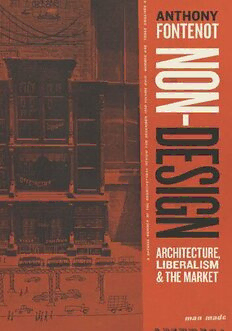Table Of ContentNon- Design
Non- Design
Architecture, LiberALism, And the mArket
Anthony Fontenot
The University of Chicago Press Chicago and London
Publication of this book has been aided by a grant from the Neil Harris Endowment
Fund, which honors the innovative scholarship of Neil Harris, the Preston and Ster-
ling Morton Professor Emeritus of History at the University of Chicago. The fund is
supported by contributions from the students, colleagues, and friends of Neil Harris.
This publication is made possible in part by the Barr Ferree Foundation Fund for
Publications, Department of Art and Archaeology, Princeton University.
The University of Chicago Press, Chicago 60637
The University of Chicago Press, Ltd., London
© 2021 by The University of Chicago
All rights reserved. No part of this book may be used or reproduced in any manner
whatsoever without written permission, except in the case of brief quotations in
critical articles and reviews. For more information, contact the University of Chicago
Press, 1427 E. 60th St., Chicago, IL 60637.
Published 2021
Printed in the United States of America
30 29 28 27 26 25 24 23 22 21 1 2 3 4 5
ISBN- 13: 978- 0- 226- 68606- 6 (cloth)
ISBN- 13: 978- 0- 226- 75247- 1 (e- book)
DOI: https:// doi .org /10 .7208 /chicago /9780226752471 .001 .0001
Library of Congress Cataloging-in-Publication Data
Names: Fontenot, Anthony, author.
Title: Non-design : architecture, liberalism and the market / Anthony Fontenot.
Other titles: Architecture, liberalism and the market
Description: Chicago ; London : The University of Chicago Press, 2021. | Includes
bibliographical references and index.
Identifiers: LCCN 2020034650 | ISBN 9780226686066 (cloth) | ISBN 9780226752471
(ebook)
Subjects: LCSH: Architecture, Modern—20th century. | Architecture—United States—
History—20th century. | City planning—History—20th century. | Design—
Philosophy. | Liberalism. | Libertarianism.
Classification: LCC NA680 .F62 2021 | DDC 720.973/0904—dc23
LC record available at https://lccn.loc.gov/2020034650
♾ This paper meets the requirements of ANSI/NISO Z39.48-1 992 (Permanence of
Paper).
To my mother,
for her endless encouragement
and for having shown me
that with diligence and patience
anything is possible
Contents
Introduction 1
1 : Planned Order versus Spontaneous Order 25
2 : New Brutalism and the Critique of Socialism: Non- Design
and the New Visual Order 54
3 : The Borax Debates: From Modern Design to Non- Design 101
4 : Spontaneous City: Jane Jacobs and the Critique of Planned Order 136
5 : Chaos or Control: Non- Design and the American City 169
6 : The Indeterminate City 214
Conclusion 266
Acknowledgments 275 Notes 277 Index 363
Introduction
One of the most fundamental critiques of design in the twentieth century
came from critics outside the discipline in a revolt against central design. The
impact on political, economic, and design theory was devastating. At the heart
of this effort to overthrow design as a form of control was the phenomenon
of non- design, a term that denotes an attitude that is characterized by a suspi-
cion and/or rejection of conscious design while embracing various phenom-
ena that emerge without intention or deliberate human design.1 Fundamental
to the philosophy of non- design is the rejection of any design of a social and
economic order made according to a centralized authority. With the revival of
liberalism, in the 1940s non- design was well articulated as a critique of collec-
tivism, evident in the theories of the Austrian- school economists Ludwig von
Mises and Friedrich August von Hayek, and espoused by many liberal critics,
including the Austria- born philosopher Karl Popper. Hayek’s work on the un-
designed nature of social institutions and his theory of spontaneous order,
understood as the result of individual action but not of human design, chal-
lenged the dominant socialist views about planning and the necessity for a
consciously designed social and economic order. These theories were devel-
oped into a doctrine that maintained a critical view of any form of rational
control of society by a central authority.
Parallel to political and economic debates, in the 1940s Hubert de Cronin
Hastings, chief editor and proprietor of the British periodical the Architectural
Review, put forth a radical theory of design known as townscape, also based
on a revival of liberalism, articulated as a revolt against aesthetic and political
tyranny.2
Exploring the philosophy of non- design in British and American design
culture, I argue in this book that the attempt to purge central design from ar-
chitecture and urban planning that emerged in the postwar period took place
for many of the same reasons that Mises, Hayek, Popper, and other liberal
thinkers gave with respect to their critique of collectivist economic planning.
By the 1960s the architectural and urban theories of Jane Jacobs, Ernst Gom-
brich, Christopher Alexander, Charles Moore, Robert Venturi and Denise Scott

